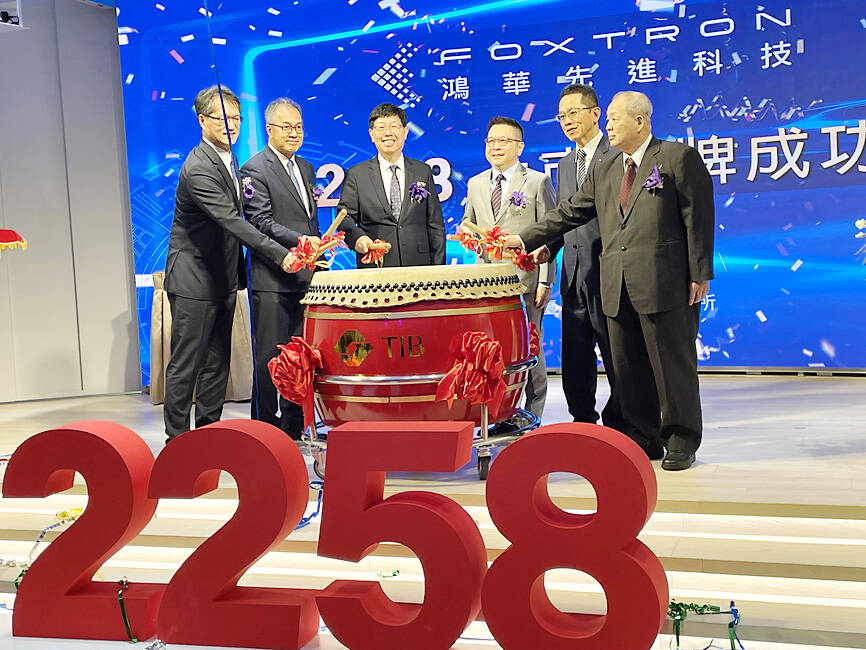Shares of Foxtron Vehicle Technologies Co (鴻華先進), an electric vehicle joint venture between Hon Hai Precision Industry Co (鴻海精密) and Yulon Motor Co (裕隆汽車), yesterday fell 2.7 percent on their debut on the Taiwan Stock Exchange’s (TWSE) new trading platform — the Taiwan Innovation Board.
Foxtron is the 1,000th listed company on the nation’s main bourse and the eighth firm trading shares on the Innovation Board, TWSE said in a statement.
The stock dropped at the open from its initial public offering price of NT$50, and at one point fell to as low as NT$45.5, before paring some losses to close 2.7 percent lower at NT$48.65, underperforming the TAIEX’s 0.01 percent rise.

Photo: CNA
Established in 2020 with paid-in capital of NT$17.41 billion (US$549.94 million), Foxtron is 49.92 percent owned by Hon Hai and 47.96 percent held by Yulon subsidiary Hua-Chuang Automobile Information Technical Center Co (華創車電), with the remainder held by other investors.
Over the past three years, the company has developed four electric vehicle (EV) prototypes: the Model B crossover sports utility vehicle, Model C sports utility vehicle, Model E luxury sedan and the Model T bus.
Unique Satellite TV quoted Foxtron CEO Andy Lee (李秉彥) as saying at yesterday’s listing ceremony that the company is starting production of the Model C this quarter and expects to begin deliveries of the model in January next year.
Foxtron hopes to complete the delivery of 8,000 to 9,000 vehicles in the first half of next year, the company said.
The Model B is expected to start volume production in the fourth quarter of next year, while the delivery of Model T buses would exceed 100 units this year, up from 20 to 30 last year, it said.
“Compared with traditional automakers, which often spend five to six years from design to mass production, Foxtron has built four EV models in less than three years, at a faster speed to popularize electric cars in Taiwan and better serve local customers,” Foxtron chairman Young Liu (劉揚偉) said at the listing ceremony yesterday.
Liu is also chairman of Hon Hai, a major Apple Inc supplier known internationally as Foxconn Technology Group (富士康科技集團).
Liu touted Foxtron’s advantages in speed, quality and cost efficiency in vehicle production, but said that “complete vehicle design” is the biggest challenge for the firm. “We would continue on this path,” he said.
Liu said Foxtron would use Taiwan as its production base and leverage Hon Hai’s “contract design and manufacturing service” (CDMS) and “build operate localize” (BOL) business models to enter mainstream markets such as North America and Southeast Asia, with electric passenger cars expected for North America initially and electric buses for Southeast Asia.
Foxtron lost NT$895 million in the first three quarters of this year, more than doubling its losses from NT$396 million a year earlier, with losses per share of NT$0.56. The company posted losses per share of NT$0.87 last year and NT$0.51 in 2021.
Cumulative sales in the first 10 months of the year rose 196.15 percent year-on-year to NT$764.7 million, company data showed.

CHIP RACE: Three years of overbroad export controls drove foreign competitors to pursue their own AI chips, and ‘cost US taxpayers billions of dollars,’ Nvidia said China has figured out the US strategy for allowing it to buy Nvidia Corp’s H200s and is rejecting the artificial intelligence (AI) chip in favor of domestically developed semiconductors, White House AI adviser David Sacks said, citing news reports. US President Donald Trump on Monday said that he would allow shipments of Nvidia’s H200 chips to China, part of an administration effort backed by Sacks to challenge Chinese tech champions such as Huawei Technologies Co (華為) by bringing US competition to their home market. On Friday, Sacks signaled that he was uncertain about whether that approach would work. “They’re rejecting our chips,” Sacks

Taiwan’s long-term economic competitiveness will hinge not only on national champions like Taiwan Semiconductor Manufacturing Co. (TSMC, 台積電) but also on the widespread adoption of artificial intelligence (AI) and other emerging technologies, a US-based scholar has said. At a lecture in Taipei on Tuesday, Jeffrey Ding, assistant professor of political science at the George Washington University and author of "Technology and the Rise of Great Powers," argued that historical experience shows that general-purpose technologies (GPTs) — such as electricity, computers and now AI — shape long-term economic advantages through their diffusion across the broader economy. "What really matters is not who pioneers

In a high-security Shenzhen laboratory, Chinese scientists have built what Washington has spent years trying to prevent: a prototype of a machine capable of producing the cutting-edge semiconductor chips that power artificial intelligence (AI), smartphones and weapons central to Western military dominance, Reuters has learned. Completed early this year and undergoing testing, the prototype fills nearly an entire factory floor. It was built by a team of former engineers from Dutch semiconductor giant ASML who reverse-engineered the company’s extreme ultraviolet lithography (EUV) machines, according to two people with knowledge of the project. EUV machines sit at the heart of a technological Cold

TAIWAN VALUE CHAIN: Foxtron is to fully own Luxgen following the transaction and it plans to launch a new electric model, the Foxtron Bria, in Taiwan next year Yulon Motor Co (裕隆汽車) yesterday said that its board of directors approved the disposal of its electric vehicle (EV) unit, Luxgen Motor Co (納智捷汽車), to Foxtron Vehicle Technologies Co (鴻華先進) for NT$787.6 million (US$24.98 million). Foxtron, a half-half joint venture between Yulon affiliate Hua-Chuang Automobile Information Technical Center Co (華創車電) and Hon Hai Precision Industry Co (鴻海精密), expects to wrap up the deal in the first quarter of next year. Foxtron would fully own Luxgen following the transaction, including five car distributing companies, outlets and all employees. The deal is subject to the approval of the Fair Trade Commission, Foxtron said. “Foxtron will be